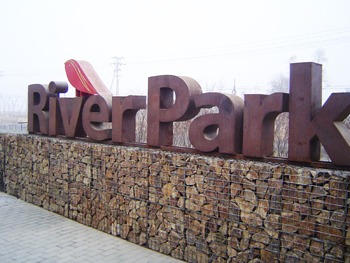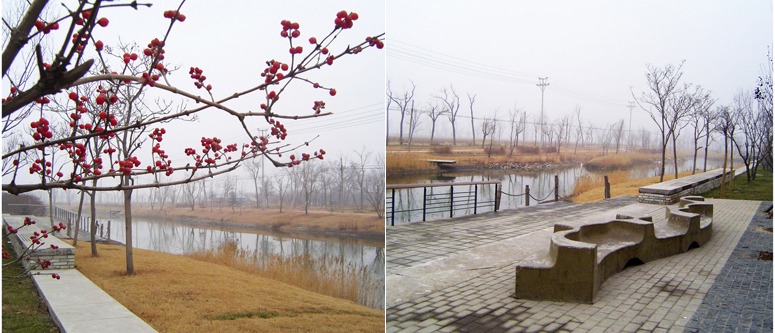中国城市化进程中的整体城市水管理:张家窝新城设计—Dreiseitl工作室 Thinking about the urban development which has taken place in mainland China since Deng Xiaoping repudiated the Cultural Revolution in 1977, the words which come to mind are: fantastic, astonishing, unbelievable and unprecedented. If, however, a laowai 老外 may be allowed a word or two of criticism (1) the work has been a little rushed (2) too few landscape architects were involved in the urban design (3) it is a pity that so much was learned from America in comparison with what was learned from Europe (4) nature in general and water in particular have suffered from the urbanisation (5) the work could have been done in a more Daoist way than it has been, with the reverence for nature which was traditional in Daoist and Buddhist culture.
With these thoughts in mind I was very pleased to read that Atelier Dreiseitl have completed a project in Zhangjiawo New Town. As noted in a review of Dreiseitl’s book on Recent Waterscapes, his work has the virtue which Lewis Mumford attributed to Ian McHarg of combining ‘scientific insight’ with ‘constructive environmental design’.
‘The Chinese seem to have been the first to perceive the relationships joining the flow of water with the shape of land and with the social and philosophical milieu.According to Joseph Needham, China produced two opposing schools of thought in hydrological engineering as in virtually ever other area of human endeavor: the Confucian and the Taoist. The Confucians were disciplinarians who believed in strict rules and strong measures of control. They advocated ‘high and mighty dykes, set nearer together’… The Taoists, or expansionists, were more inclined to let water take its own course as far as possible, giving it plenty of room to spread. The result was a very complex network of flow. An early Taoist engineer, one Chia Jang, wrote over 3000 years ago that ‘those who are good at controlling water give it the best opportunities to flow away; those who are good at controlling the people give them plent of chance to talk’ (John Tillman Lyle, Design for human ecosystems: landscape, land use, and natural resources (1999, p.236)
The American approach to water management was Confucian, in the sense of regulatory. But McHarg introduced a more Daoist approach in the famous project for Woodlands, Texas. It proved to be more beautiful, more effective and more ecological. And it came in at 25% of the cost of the US engineers ‘Confucian’ system. As McHarg observed ‘there is no better union than virtue and profit’. I therefore hope Dreiseitl is re-pioneering a Daoist approach to holistic urban water management in the formerly Daoist Middle Kingdom. Continental European cities, because so many of them were founded in the Middle Ages, have a long tradition of incorporating open water channels within the fabric of the city. American cities, because so many of them date from the nineteenth century, have tended to put as much urban water as possible into underground pipes. China seems to have done things the American way, so far.
Images courtesy Tian Yuan


I wonder if Dreiseitl’s projects can embody something of the aesthetic qualities of the ‘Underwater Dance’?
[ http://www.behance.net/gallery/underwater-dance/45918 ]
Or a gritty Modernity? [ http://www.behance.net/gallery/Urban-Places/333678 ]
Degas might be envious if Herbert Dreiseitl could achieve the aesthetic of an underwater dance.
It is only as a photographer that I appreciate the Gritty Modernity.
Well yes. And yet the two images have been combined in a critique on the reification of Jane Jacobs with the hope for the emergence of a Chinese Jane:
“Jacobs founded a powerful myth of urbanism, that the sine qua non of urban form was to found in the ‘ballet of Hudson Street’, and with it created such as narrow definition of what represents vitality in cities that it can only be achieved with the values that Jacobs proscribed, and that conversely, anything that ignores any of these principles must be doomed to failure. The New Urbanists have taken a set of observations from Death and Life of Great American Cities, and turned them into design guidelines, a form of environmental determinism that in many ways is the exact opposite of what Jacobs wrote and stood for. The Death and Life of Great American Cities is a compelling read, but it is deeply flawed book.”
[ http://newsfeed.kosmograd.com/kosmograd/2010/06/the-ballet-of-ipod-city-1.html ]
I love the idea of a Chinese Jane – but what would be the equivalent of ‘Jane’, with its welcome connotations of ‘someone with common sense who believes in plain speaking’?
I would not say that Jacobs is ‘deeply flawed’; it is one recipie for good urban space – and cities need fat recipie books.
Samuel Staley would be a good person to engage in conversation with Chinese Jane as he states the problem quite succinctly….Urbanism in China is well, despite all its Western appearances, peculiarly Chinese.[ http://www.planetizen.com/node/24437 ] What makes it so? It seems superdensity is one of the attributes of Chinese Megacities. One of the primarily problems as Samuel sees it is the potential loss of ‘human scale.’
Perhaps the rise of the Megacity is a Post postmodern phenomenon?
[ http://en.wikipedia.org/wiki/Megacity ]
I agree with Samuel Staley about the inhuman scale of Megacities, though I suppose people will get used to this, as they do to most things, but I am doubtful about superdensity making cities or buildings essentially different. Living in a 100 story appartment block is, I imagine, much like living in a 10 story appartment block, just as driving on 10-lane road is much like driving on a 4-lane road. But I am pleased that Europe does not have any megacities.
Actually living in a 10 story apartment block
[ http://ads.rentbits.com/img/user/7557/25474/1.jpg ]is quite different to living in a 100 story apartment block. [ http://www.michaelturton.com/Taiwan/taipeinov03_06.jpg ] This building in Taipei one is a 100 storys (and although not an apartment block)I guess you can appreciate the difference?
As for roads
[ http://www.bbc.co.uk/kent/content/images/2006/07/03/sheppey_crossing_road_view_470x355.jpg ], you are right, ditto. This eight + two lane road in the US is called a beltway: and is probably a good example as far as ten lanes go.[ http://www.capital-beltway.com/ALMB-Widened.jpg ]
I have never lived in an apartment block however (1) I can see that a 10-story block looks very different from a 100-story block (2) if one lives on the 10th floor of a 10-story block is it a different experience from living on the 10th floor of a 100-story block (3) if one lives on the 10th floor of a 10-story block on a hill (to get a wide view), is it any different from living on the 100th floor of a 100-story block which is not on a hill? Sorry to be pernickity! But I do think that living in a house with a garden is a different experience in kind to living in an appartment.
The photograph of the beltway looks very like the road to the Forth Bridge, outside Edinburgh (though I believe it is blocked by unseasonal snow this week – said to be caused by global warming).
The answer to question (3) is yes. It may be that you are talking to someone who is particularly spatially and experientially sensitive but I would say the ten story apartment on the hill is very different to the one hundred story apartment.
Step one: In your imagination leave the top most apartment of each block and exit via the fire escape stairs, now via the lift and lastly from your apartment window rescued by the fire brigade.
Step two: Now leave messages with all of the residents in both apartment blocks informing them you are having a New Years Eve party on the roof and that they are welcome to attend and that you will be catering.
Step three: You have found keys belonging to someone in the block consider how you might locate the owners and return the keys.
Step four: The body corporate has decided to renovate the apartment block and install a pool they are seeking contributions from all residents on a per m2 basis. They have invoiced you for your share.
Step five: Someone has been gone missing from the apartment block and the police are interviewing all residents including yourself to ascertain how well and what they know about the missing person. Do you know him and what can you tell them?
Step six: Someone is proposing to build a ten story apartment in front of your block which will largely obscure the ocean views, how do the residents of your block feel in general about this development?
Step seven: Friday night is party night and every second apartment in the block is occupied by dedicated revellers. You work night shift. Are you going to buy earplugs?
Step eight: The airconditioning (heating and cooling) in the apartment block is not operating and is expected to be undergoing repairs and maintenance for a month. How are you feeling?
Step nine: The body corporate has just given permission for small dogs and cats to be allowed in the apartments. You start to wonder what the limits of the description ‘small’ are?
Step ten: There are rumours that one of the apartments has been sold to a famous landscape architect. You wonder where on the property he might be gardening or whether this is just his city apartment?
All thoughtful points, but more related to the social experience of appartment living than to the experience of living in an appartment. The nearest I have been to the experience is in hotels and on those occasions I have rather enjoyed both the social isolation of being way above the ground and the views that have been obtained by the lofty elevation. I can’t promise it, but I can see that I could do with some real experience of appartment living.